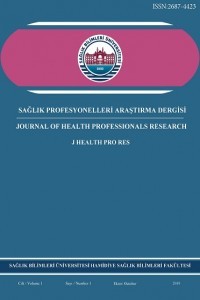Bening Eklem Hipermobilite Sendromu Olan ve Olmayan Lisans Fizyoterapi Öğrencilerinde Alt Ekstremite Kas Gücü ve Denge Skorlarının Karşılaştırılması
Amaç: Bu çalışmanın amacı, eklem hipermobilitesi olan ve olmayan üniversite öğrencilerinde alt ekstremite kas gücü ile denge skorlarının karşılaştırılmasıdır.Gereç ve Yöntem: Çalışma sağlık bilimleri fakültesi fizyoterapi ve rehabilitasyon bölümü öğrencilerinde gerçekleştirilmiştir. Çalışmaya 35 gönüllü öğrencisi dahil edilmiştir. Katılımcılar Beighton skoruna göre gruplandırılmışlardır. Her iki grubun alt ekstremite kas gücü ve denge skorları ölçülüp karşılaştırılmıştır.Bulgular: İki grubun sosyodemografik değerleri, fiziksel aktivite kapasitesi arasında bir fark yoktur. Ayrıca her iki grubun kas gücü ve Flamingo denge testi sonuçları karşılaştırılması sonucunda da anlamlı bir fark bulunamamıştır. Sonuç: Çalışmamızda hipermobilite ile alt ekstremite kas gücü ve statik denge arasında ilişki bulunamamıştır. Anahtar Kelimeler: Beighton skoru; hipermobilite; flamingo denge testi; kas kuvveti
Anahtar Kelimeler:
Beighton skoru, hipermobilite, flamingo denge testi, kas kuvveti
Comparison of Lower Extremity Muscle Strength and Balance Scores in Physiotherapy Bachelor Students with or Without Benign Hypermobility Syndrome
Aim: The aim of this study was to compare the lower extremity muscle strength and balance scores in university students with and without joint hypermobility. Method: The study was performed in faculty of health science. 35 volunteer students attended to this study. The participants were grouped according to the Beighton score. The lower extremity muscle strength and balance scores of both groups were assessed and evaluated.Results: There is no significant difference between the sociodemographic values and the physical activity capacity of the two groups. In addition, there was no significant difference between the muscle strength and Flamingo balance test results of both groups. Conclusion: There was no relationship between hypermobility and lower extremity muscle strength and static balance.
___
- [1] Jindal, P., Narayan, A., Ganesan, S., & MacDermid, J. C. (2016). Muscle strength differences in healthy young adults with and without generalized joint hypermobility: a cross-sectional study. BMC sports science, medicine and rehabilitation, 8(1), 12.
- [2] Iatridou, K., Mandalidis, D., Chronopoulos, E., Vagenas, G., & Athanasopoulos, S. (2014). Static and dynamic body balance following provocation of the visual and vestibular systems in females with and without joint hypermobility syndrome. Journal of bodywork and movement therapies, 18(2), 159-164.
- [3] Stanley P. Brown, Wayne C. Miller JME. Female-specific issues. In: exercise physiology: basis of human movement in health and disease. Lippincott Williams & Wilkins; 2006. p. 405–28.
- [4] Schmidt, H., Pedersen, T. L., Junge, T., Engelbert, R., & Juul-Kristensen, B. (2017). Hypermobility in adolescent athletes: pain, functional ability, quality of life, and musculoskeletal injuries. journal of orthopaedic & sports physical therapy, 47(10), 792-800.
- [5] Ambegaonkar, J. P., Cortes, N., Caswell, S. V., Ambegaonkar, G. P., & Wyon, M. (2016). Lower extremity hypermobility, but not core muscle endurance influences balance in female collegiate dancers. International journal of sports physical therapy, 11(2), 220.
- [6] Sahin, N., Baskent, A., Cakmak, A., Salli, A., Ugurlu, H., & Berker, E. (2008). Evaluation of knee proprioception and effects of proprioception exercise in patients with benign joint hypermobility syndrome. Rheumatology International, 28(10), 995-1000.
- [7] Scheper, M., de Vries, J., Beelen, A., de Vos, R., Nollet, F., & Engelbert, R. (2014). Generalized joint hypermobility, muscle strength and physical function in healthy adolescents and young adults. Current rheumatology reviews, 10(2), 117-125.
- [8] Clifton, D. R., Harrison, B. C., Hertel, J., & Hart, J. M. (2013). Relationship between functional assessments and exercise-related changes during static balance. The Journal of Strength & Conditioning Research, 27(4), 966-972.
- [9] Beydağ Odabaşı, B. (2009). Kas iskelet sistemi problemi olan hastalarda hipermobilite sıklığı ve tespit edilen hipermobil hastalardaki kas iskelet sistemi problemlerinin dağılımı (Doctoral dissertation, Adnan Menderes Üniversitesi, Tıp Fakültesi).
- [10] Ozcan, A., Donat, H., Gelecek, N., Ozdirenc, M., & Karadibak, D. (2005). The relationship between risk factors for falling and the quality of life in older adults. BMC Public Health, 5(1), 90.
- [11] Walaszek, R., Chwała, W., Walaszek, K., Burdacki, M., & Błaszczuk, J. (2017). Evaluation of the accuracy of the postural stability measurement with the Y-Balance Test based on the levels of the biomechanical parameters. Acta of bioengineering and biomechanics, 19(2).
- [12] Hazar, F., & Taşmektepligil, Y. (2008). Puberte öncesi dönemde denge ve esnekliğin çeviklik üzerine etkilerinin incelenmesi. Spormetre Beden Eğitimi ve Spor Bilimleri Dergisi, 6(1), 9-12.
- ISSN: 2687-4423
- Yayın Aralığı: Yılda 3 Sayı
- Başlangıç: 2019
- Yayıncı: Sağlık Bilimleri Üniversitesi
Sayıdaki Diğer Makaleler
Genital Sistem Enfeksiyonlarının Önlenmesi ve Ebelik
Pes Planuslu Olan ve Olmayan Üniversite Öğrencisi Kadın Bireylerde Statik Dengenin Değerlendirilmesi
Ümran ZARARSIZ, Zuhal Didem TAKİNACI
Cansu AK, Zuhal Didem TAKİNACI
Sirkadiyen Ritim İle Yeme Zamanı İlişkisi
Rezeksiyonsuz Proksimal Ostomili Hastada Farklı Fizyolojik Beslenme Uygulaması
Elvan YILMAZ AKYÜZ, Cebrail AKYÜZ
Ebelik Uygulamalarında Mahremiyet
